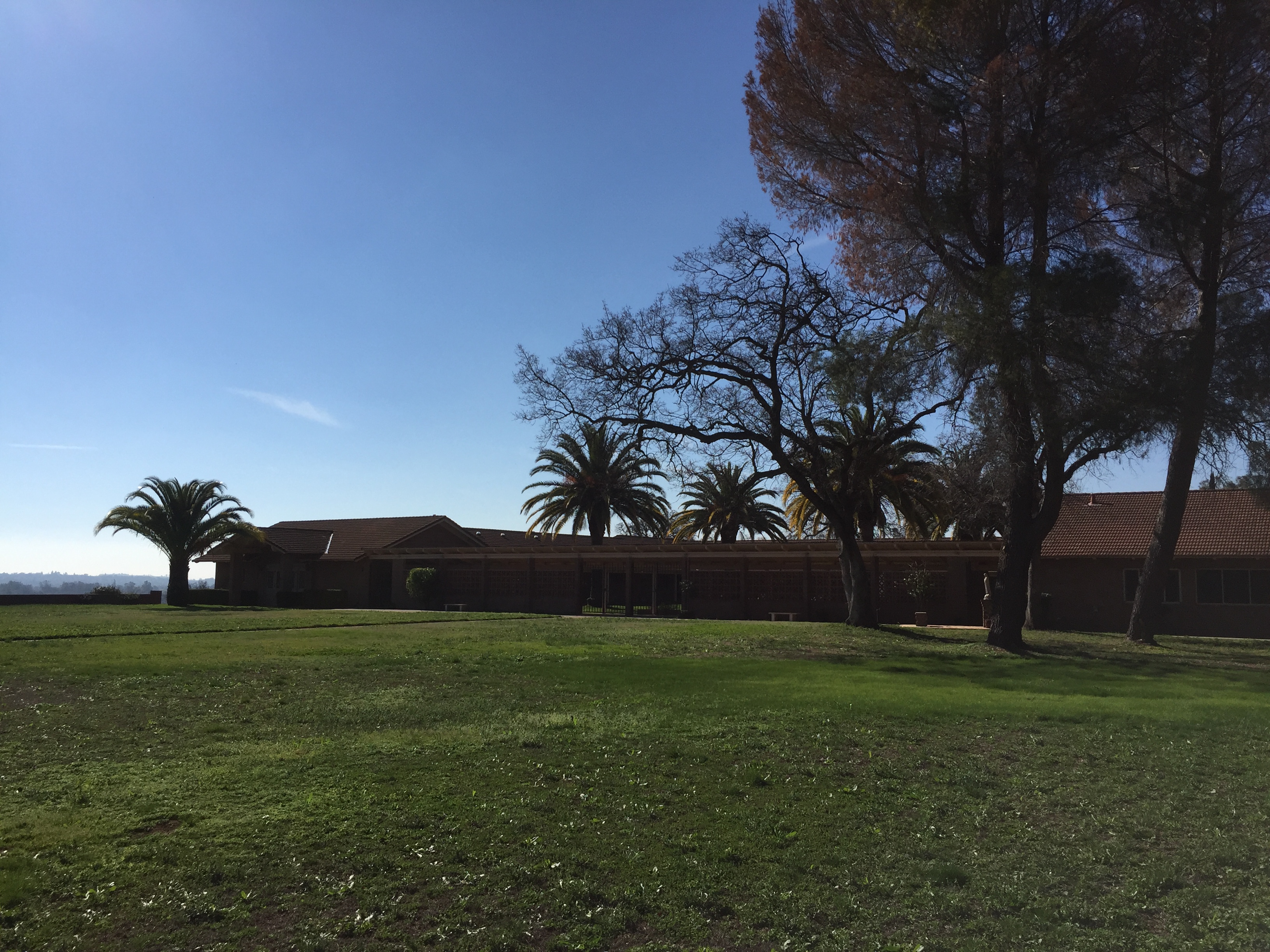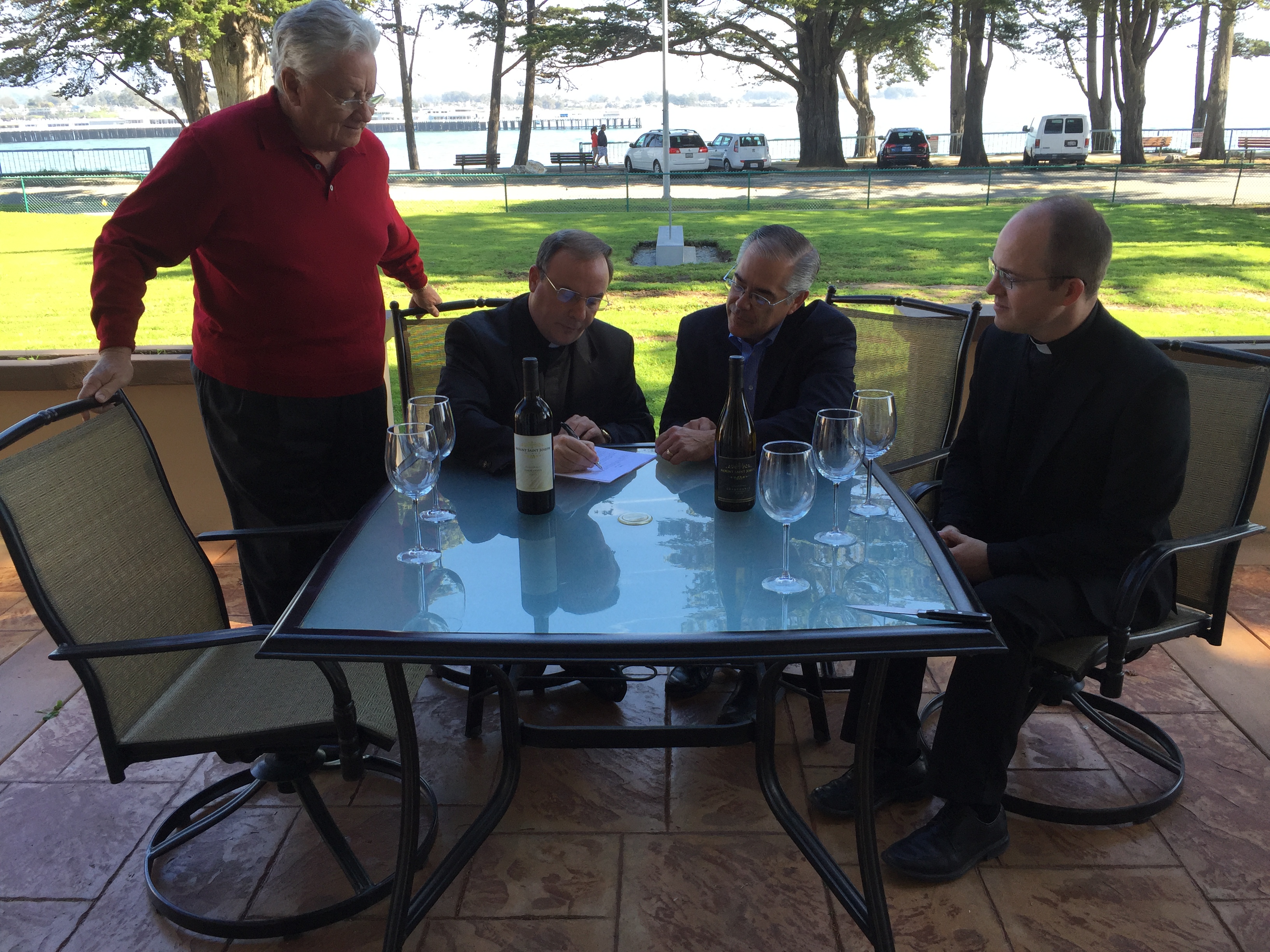MSJ Vineyards
Sustainable Winegrowing Practices
Our vineyard has been flourishing on the beautiful Loomis property of the Oblates of St. Joseph since 2016. Cabernet Franc, Petit Verdot and Petite Syrah varietals were first harvested in 2020.
Mount Saint Joseph Wines is committed to sustainable winegrowing practices.
Mount Saint Joseph Wines LLC has performed a self assessment of its vineyard, winemaking and tasting room operations relative to the California Code of Sustainable Winegrowing Workbook. Of the 197 sustainable practice criteria presented in the workbook, 135 were found to be applicable to our operations. Results of the self evaluation are being used to guide improvement of sustainable practices. Listed below are some of the more important sustainable practices currently being employed.
Sustainable Business Strategy
- Sustainability is integrated into our business strategy - mission, vision, goals and values.
- To the best of our relevant staff’s knowledge, our operations are in compliance with applicable legal and environmental regulatory requirements.
- Sustainability is being integrated into our communications and marketing strategies.
Viticulture
- Vineyard design (spacing, trellising and training), pruning, crop load adjustments, irrigation, and cover cropping are used to keep vines in balance.
- Shoots are thinned to optimum spacing along cordons, equally distributing fruit.
- Laterals and leaf removal is performed where needed to expose clusters to the
- appropriate amount of indirect light.
- Fruit thinning is performed to manage yield to target levels and enhance wine grape
- quality.
- Trellis and vine spacing accommodates vine vigor and provides an open canopy with moderate exposure of the fruiting zone.
- Vines are pruned differentially to match their vigor and achieve uniform vegetative
- growth.
- Canopy density and shoot-tip vigor are monitored to guide irrigation.
- Root stocks and scions were selected to thrive in our vineyard locale and soil
- conditions.
- Vineyard rows were oriented and spaced with consideration of prevailing wind and sunlight angle.
- Buffer zones of native vegetation within and adjacent to the vineyard are maintained for wildlife habitat and pest predators.
Soil Management
- Plant tissue analyses are used to guide nutrient application decisions.
- Vine vigor, fruit quality, and leaf symptoms are factored into decisions for nutrient
- applications.
- Nitrogen supplements are applied when best utilized by vines and guided by plant tissue analysis and vine vigor.
- Fertigation is used to target efficient application of soil nutrients.
- Vine cuttings are mulched to increase organic matter and support cover crops.
- No tilling is performed between vine rows promoting permanent cover crops and preserving organic matter.
- Light weight mowers and ATVs are used to reduce soil compaction in vine rows.
Vineyard Water Management
- Our water management strategy considers fruit yield/quality, canopy characteristics, vineyard floor management, soil types and slopes, and wate application efficiency.
- Irrigation is accomplished using an engineered drip irrigation system segmented by blocks of grape varietals.
- Irrigation canal water is metered and filtered.
- Soil moisture, visual assessment of vine stress, and weather forecasts are used to provide sufficient water during vine growth and fruit development, regulated deficit irrigation during maturing of fruit.
Pest Management
- Our vineyard is periodically monitored for insect and mite pests during the growing season.
- Buffer zones of vegetation are maintained to support “beneficials”.
- Non-target risks and human health are considered when selecting and using insecticides and miticides.
- Dust is abated by permanent cover crop and limited mowing.
- Cultural practices (shoot thinning and lateral/leaf removal) are used to help limit development of powdery mildew.
- Vines are pruned in late dormancy for canker management.
- Fungicides to prevent bunch rot are applied only between bloom and bunch closure.
- The vineyard is monitored periodically for invasive weeds.
- Contact herbicides are only to treat vine row berms and along perimeter fences.
- The vineyard is monitored for diseases during critical periods.
- Pesticide applications are avoided when conditions would lead to drift.
- Habitat modification, raptor perches and exclusion fencing (for deer) are used to control vertibrate pests - no toxic bates or fumigants are used.
- Solar powered Bird Guard units are deployed to limit crop damage by birds.
Wine Quality
- Fruit and vines (Brix, pH, TA, cane lignification, grape seed color and grape juice taste) are monitored to optimize time for harvesting.
- Grape harvesting is started before sun up, and grapes are immediately transported to the winery for processing.
- Our wine is made and bottled in facilities and with equipment that minimize food safety risks.
- Wine made from grapes maturing in barrels is periodically tasted in concert with our winemaker.
- Our finished wines are entered in judged competitions, priced and marketed commensurate with wine quality.
- Characteristics of finished wines are considered in making viticultural improvements to our vineyard.
Ecosystem Management
- Our vineyard was designed, constructed and is being maintained with consideration to the ecosystem in which it is situated.
- The watershed from which irrigation canal water is provided is known and understood.
- Riparian habitat - banks of irrigation canal include a vegetated buffer and rows of trees to shade the water course.
- Wildlife habitat is enhanced in areas above leach fields within and adjacent to the vineyard.
Energy Efficiency
- Energy usage (electricity and petroleum fuels) is recorded and efforts employed to improve energy efficiency.
- Water pumping volume/duration is limited by planned deficit irrigation.
- No tilling of cover crops within vineyard rows and bordering areas is performed to limit fuel usage by mowing equipment.
- Solar powered vineyard met stations and Bird Guard units.
- Our tasting room was designed and tenant improvements made in full compliance with California Building Energy Efficiency Standards - Title 24.
Solid Waste Reduction and Management
- Metal, paper, cardboard, glass and plastic are recycled in designated recycling containers.
- Vine cuttings and cover crop cutting are mulched within vine rows.
Sustainable Purchasing
- Recyclability of materials and packaging are taken into consideration together with quality, dependability, and cost in making purchasing decisions.
Human Resources
- Contractors and employees are carefully interviewed based on desired skills, and to determine experience and demonstrated proficiency.
- Employees are oriented and trained relative to defined responsiblities and safe work practices.
- Prevailing fees are paid to vineyard maintenance contractors for specific services.
- Prevailing wages are paid to our tasting room employees.
Neighbors and Community
- The vineyard and its perimeter buffer are maintained to enhance the aesthetic beauty of the neighborhood.
- No night time lighting of the vineyard.
- Water pumping equipment housed in shed to reduce noise.
- Bird Gard units used to mitigate crop damage by birds - no sonic cannons are used.
- Gratuities generated by owner volunteers working in our tasting room are donated to
- local charities.
- Lease payment for our vineyard support the Oblates of St. Joseph, a Catholic order.
- Wine tasting parties are donated to local charities and non-profit organizations.
- Local artists and artisans are featured in our tasting room.
Air Quality
- Potential sources (point and fugitive) of air pollution associated with our vineyard are understood and efforts made to control/minimize emissions.
- Vegetated floor of cover crops maintained to mitigate fugitive particulate emissions.
- All roadways and staging areas are paved.
- Pesticide stewardship involves observance of recommended practices to minimize particulate matter and drift.
- Vine cuttings are mulched vs. burned.
Mount St. Joseph
Our vineyard is in the Sierra foothills of Loomis, California. The climate and topography are perfect for the Cabernet Franc, Petit Verdot and Petite Syrah varietals we have planted.
Novitiate of St. Joseph
The Novitiate is where the Oblates of St. Joseph live and worship in tranquility. It overlooks our vineyard to the north.
A Long Term Relationship
Mount Saint Joseph Wines and the Oblates of St. Joseph are committed to a long term relationship.



